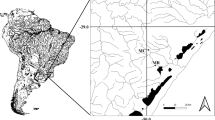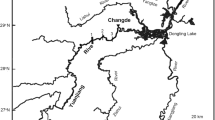Abstract
Seasonal distribution, biology of reproduction, body length/weight composition, age of sexual maturation, and features of feeding in wels catfish Silurus glanis from the Volga River channel areas within the Volga–Ahtuba water systems (the lower Volga) have been studied. Within the study region, wels habitats are confined to the system of river-channel pits and to the deep-water sites of the main river channel; the fish roam within the surroundings of the pits. Wels spawns in the waterbodies of the subordinate system of the river: eriks (shallow channels) and branches between the Volga and Ahtuba rivers. In the study region, wels is represented by a long-lived late-maturing group. The fish of different body lengths/weights differ in the feeding modes: the specimens with body weights of <5 kg consume various small-sized prey, including nonfish food; larger individuals feed on large fish prey. Comparative analysis of the structures of wels populations from the Volga River delta and channel areas revealed considerable differences indicating the presence of two spatial groups of the population or subpopulation ranks: deltaic migrant and river channel settled. Development of an optimal strategy for exploitation of this valuable fish necessitates a differentiated approach and detailed analysis of biological traits of this species within the Volga basin. Such analysis should include population-genetic methods.



Similar content being viewed by others
REFERENCES
Alp, A., Kara, C., and Buyukcapar, H.M., Reproductive biology in a native European catfish, Silurus glanis L., population in Menzelet Reservoir, Turk. J. Vet. Anim. Sci., 2004, vol. 28, pp. 613–622.
Alp, A., Kara, C., Uckardes, F., et al., Age and growth of the European catfish (Silurus glanis) in a Turkish Reservoir and comparison with introduced populations, Rev. Fish. Biol. Fish., 2011, vol. 21, pp. 283–294.
Anthouard, M., Pionnier, E., and Kirsch, R., Behavioral adaptation of Silurus glanis (Pisces, Cypriniformes, Siluridae) in an instrumental conditioning situation, in Actes du Colloque de la Société Française pour l’Etude du Comportement Animal, Cloarec, A., Ed., Rennes: Univ. Rennes, 1987, pp. 72–75.
Barabanov, V.V., Prosvirin, D.N., and Nikiforov, S.Yu., Effect of amateur fishing on aquatic biological resources of Volga-Caspian fishery subregion (Astrakhan oblast), Rybovod. Rybn. Khoz., 2016, no. 5, pp. 35–42.
Barabanov, V.V., Shipulin, S.V., Kanat’ev, S.V., and Tkach, V.N., Scientific research of amateur fishing in Volga-Caspian basin (Astrakhan oblast), Rybn. Khoz., 2017, no. 2, pp. 70–74.
Berg, L.S., Ryby presnykh vod i sopredel’nykh stran (Fishes of Freshwaters and Adjacent Countries), Moscow: Akad. Nauk SSSR, 1949, vol. 2.
Borisenko, E.S., Mochek, A.D., Pavlov, D.S., et al., Use of hydroacoustic methods of remote scanning for evaluation of abundance and species composition of fishes in the channel of Volga and Akhtuba rivers (Lower Volga basin), Materialy II Vserossiiskoi konferentsii “Sovremennoe sostoyanie bioresursov vnutrennikh vod” (Proc. II All-Russ. Conf. “Modern Status of Biological Resources of Inland Waters”), Moscow: Poligraf-Plyus, 2014, vol. 1, pp. 86–90.
Boujard, T., Diel rhythms of feeding activity in the European catfish, Silurus glanis, Physiol. Behav., 1995, vol. 58, pp. 641–645.
Britton, J.R., Pegg, J., Sedgwick, R., and Page, R., Using mark-recapture to estimate catch rates and growth of the European catfish Silurus glanis in a recreational fishery, Fish. Manage. Ecol., 2007, vol. 14, pp. 263–268.
Bruton, M.N., Alternative life-history strategies of catfishes, Aquat. Living Resour., 1996, vol. 9, pp. 35–41.
Carol, J., Benejam, L., Alcaraz, C., et al., The effects of limnological features on fish assemblages of 14 Spanish reservoirs, Ecol. Freshwater Fish., 2007a, vol. 15, pp. 66–77.
Carol, J., Zamora, L., and García-Berthou, E., Preliminary telemetry data on the patterns and habitat use of European catfish (Silurus glanis) in a reservoir of the River Ebro, Spain, Ecol. Freshwater Fish., 2007b, vol. 16, pp. 450–456.
Carol, J., Benejam, L.B., and García-Berthou, E., Growth and diet of European catfish (Silurus glanis) in early and late invasion stages, Fund. Appl. Limnol., 2009, vol. 174, pp. 317–328.
Clarke, S., CCG Guide to UK Catfish Waters, Farnham: Catfish Conserv. Group, 2005.
Copp, G.H., Moffatt, L., and Wesley, K.J., Is European catfish Silurus glanis really becoming more abundant in the River Thames? Aquat. Invasions, 2007, vol. 2, pp. 113–116.
Copp, G.H., Britton, R., Cucherousset, J., et al., Voracious invader or benign feline? A review of the environmental biology of European catfish Silurus glanis in its native and introduced ranges, Fish Fish., 2009, vol. 10, pp. 252–282.
David, J.A., Water quality and accelerated winter growth of European catfish using an enclosed recirculating system, Water Environ. J., 2006, vol. 20, pp. 233–239.
Davies, C., Shelley, J., Harding, P., et al., Freshwater Fishes in Britain: The Species and Their Distribution, Colchester: Harley Books, 2004.
Elvira, B. and Almodóvar, A., Freshwater fish introductions in Spain: facts and figures at the beginning of the 21st century, J. Fish Biol., 2001, vol. 59, pp. 323–331.
Fomichev, O.A., Abbakumov, V.P., Ermilova, L.S., et al., Large freshwater fish species, reserves, and fishery in Caspian area, in Rezul’taty NIR za 2015 god “Rybokhozyaistvennye issledovaniya na Kaspii” (The Results of Scientific-Research Work in 2015 “Fishery and Economic Studies in Caspian Region”), Astrakhan: Kasp. Nauchno-Issled. Inst. Rybn. Khoz. Okeanogr., 2006, pp. 213–230.
Fortunatova, K.R., The analysis of feeding of raptorial fishes, in Rukovodstvo po izucheniyu pitaniya ryb v estestvennykh usloviyakh (Manual for Analysis of Feeding of Fishes in Nature), Moscow: Nauka, 1961, pp. 137–187.
Fortunatova, K.R., Behavior of raptorial fishes depending on ecology of food organisms by example of the catfish and asp, Tr. Inst. Morfol. Zhivotn., Akad. Nauk SSSR, 1962, no. 42, pp. 25–32.
Fortunatova, K.R., and Popova, O.A., Pitanie i pishchevye vzaimootnosheniya khishchnykh ryb v Del’te Volgi (Feeding and Food Chains of Raptorial Fishes in the Volga River Delta), Moscow: Nauka, 1973.
Freshwater Fishes of Europe, Vol. 1, Part 2: General Introduction to Fishes. Acipenseriformes, Holčik, J., Ed., Wiesbaden: AULA-Verlag, 1989.
Girsa, I.I., Osveshchennost’ i povedenie ryb (Illumination and Behavior of Fishes), Moscow: Nauka, 1981.
Harka, A., Studies on the growth of the sheatfish (Silurus glanis L.) in River Tisza, Aquacult. Hung., 1984, vol. 4, pp. 135–144.
Harka, A. and Biro, P., Probable sources of biased estimates of growth in wels (Silurus glanis L.) using fin rays, Aquacult. Hung., 1990, vol. 6, pp. 35–39.
Hickley, P. and Chare, S., Fisheries for non-native species in England and Wales: angling or the environment, Fish. Manage. Ecol., 2004, vol. 11, pp. 203–212.
Hilge, V., The influence of temperature on the growth of the European catfish (Silurus glanis L.), J. Appl. Ichthyol., 1985, vol. 1, pp. 27–31.
Horoszewicz, L. and Backiel, T., Growth of wels (Silurus glanis L.) in the Vistula River and the Zegrzynski Reservoir, Arch. Pol. Fish., 2012, vol. 20, pp. 201–205.
Kazancheev, E.N., Ryby Kaspiiskogo morya (Fishes of the Caspian Sea), Moscow: Nauka, 1981.
Koblitskaya, A.F., Izuchenie nerestilishch presnovodnykh ryb (Analysis of Spawning Sites of Freshwater Fishes), Moscow: Pishchevaya Prom-st, 1966.
Kolosyuk, G.G. and Tkach, V.N., Comparison of dynamics of size-weight and age structure of freshwater catfish in Volga-Caspian and North Caspian fishery subregion, Materialy II Vserossiiskoi konferentsii “Sovremennoe sostoyanie bioresursov vnutrennikh vod” (Proc. II All-Russ. Conf. “Modern Status of Biological Resources of Inland Waters”), Moscow: Poligraf-Plyus, 2014, vol. 1, pp. 285–289.
Krieg, F., Triantafyllidis, A., and Guyomard, R., Mitochondrial DNA variation in European populations of Silurus glanis, J. Fish Biol., 2000, vol. 56, pp. 713–724.
Kushnarenko, A.I., Fomichev, O.A., Sidorova, M.A., et al., Reserves and fishery forecast of semi-migratory fishes in 2005, in Rybokhozyaistvennye issledovaniya na Kaspii. Rezul’taty NIR za 2003 god (Fishery Economic Studies in the Caspian Region: The Results of Scientific-Research Work in 2003), Astrakhan: Kasp. Nauchno-Issled. Inst. Rybn. Khoz., 2004, pp. 293–305.
Kuzishchin, K.V., Samoilov, K.Y., Gruzdeva, M.A., and Pavlov, D.S., Distribution, population structure, and some biological distinctions of pikeperch Sander lucioperca of the channel part of the Akhtuba River (Volga–Akhtuba water system), J. Ichthyol., 2016, vol. 56, no. 5, pp. 702–714.
Linhart, O., Stech, L., Svarc, J., et al., The culture of the European catfish, Silurus glanis, in the Czech Republic and in France, Aquat. Living Resour., 2002, vol. 15, pp. 139–144.
Lysenko, N.F., Morphology of European catfish (Silurus glanis) from Balkhash Lake and its population, Vopr. Ikhtiol., 1978, vol. 18, no. 6, pp. 850–856.
Nikolaev, V.A., Geological history, relief, and alluvial deposits in the Akhtuba River, in Priroda i sel’skoe khozyaistvo Volgo-Akhtubinskoi doliny i del’ty (Nature and Agriculture in Volga-Akhtuba Valley and Delta), Moscow: Mosk. Gos. Univ., 1962, pp. 11−149.
Orlova, E.L., Reserves of catfish in Volga-Caspian area, Rybn. Khoz., 1973, no. 11, pp. 9–11.
Orlova, E.L., Specific growth and maturing of the European catfish Silurus glanis L. in the Volga River delta in regulated run-off, Vopr. Ikhtiol., 1987, vol. 27, no. 6, pp. 945–955.
Orlova, E.L. and Popova, O.A., Specific feeding of raptorial fishes—European catfish Silurus glanis L. and northern pike Esox lucius L. in the Volga River delta after regulation of river run-off, Vopr. Ikhtiol., 1976, vol. 16, no. 1 (96), pp. 84–98.
Orlova, E.L. and Popova, O.A., Feeding of raptorial fishes depending on concentration of food organisms, Vopr. Ikhtiol., 1986, vol. 26, no. 5, pp. 757–764.
Orlova, E.L. and Popova, O.A., Age changes in feeding of the European catfish Silurus glanis L. and pike Esox lucius L. in the Volga River delta, Vopr. Ikhtiol., 1987, vol. 27, no. 1, pp. 140–148.
Pavlov, D.S., Biologicheskie osnovy upravleniya povedeniem ryb v potoke vody (Biological Principles of the Control of Fish Behavior in Water Flow), Moscow: Nauka, 1979.
Pavlov, D.S., Mochek, A.D., Borisenko, E.S., et al., Distribution of fishes in the floodplain-channel complex of the lower reaches of the Irtysh River, Inland Water Biol., 2011, vol. 4, no. 2, pp. 223–231.
Pohlmann, K., Grasso, F.W., and Breithaupt, T., Tracking wakes: the nocturnal predatory strategy of piscivorous catfish, Proc. Natl. Acad. Sci. U.S.A., 2001, vol. 98, no. 13, pp. 7371–7374.
Pravdin, I.F., Rukovodstvo po izucheniyu ryb (Manual for Analysis of Fishes), Moscow: Pishchevaya Prom-st’, 1966.
Schlumberger, O., Sagliocco, M., and Proteau, J.P., Biogéographie du silure glane (Silurus glanis): causes hydrographiques, climatiques et anthropiques, Bull. Fr. Piscic., 2001, vols. 357–360, pp. 533–547.
Sibirtsev, G.G., Biological features of fishing in the Volga delta, Vopr. Ikhtiol., 1967, vol. 7, no. 2 (43), pp. 247–257.
Triantafyllidis, A., Krieg, F., Cottin, C., et al., Genetic structure and phylogeography of European catfish (Silurus glanis) populations, Mol. Ecol., 2002, vol. 11, pp. 1039–1055.
Wolter, C. and Freyhof, J., Diel distribution patterns of fishes in a temperate large lowland river, J. Fish Biol., 2004, vol. 64, pp. 632–642.
Wysujack, K. and Mehner, T., Can feeding of European catfish prevent cyprinids from reaching a size refuge? Ecol. Freshwater Fish., 2005, vol. 14, pp. 87–95.
Yilmaz, S., Yilmaz, M., and Polat, N., Evaluation of different bony structures to age of catfish (Silurus glanis L., 1758) inhabiting Altınkaya Dam Lake (Samsun-Turkey), Sci. Eng. J. Firat Univ., 2007, vol. 19, pp. 7–11.
Zaikov, A., Iliev, I., and Hubenova, N., Investigation on growth rate and food conversion ratio of wels (Silurus glanis L.) in controlled conditions, Bulg. J. Agric. Sci., 2008, vol. 14, no. 2, pp. 171–175.
Zvolinskii, V.P., Ovchinnikov, A.S., Yakovlev, S.V., and Rybashlykova, L.P., Kompleksnyi monitoring vodnykh biologicheskikh resursov vodoemov Volgo-Akhtubinskoi poimy (Complex Monitoring of Aquatic Biological Resources of Reservoirs of Volga-Akhtuba Floodplain), Volgograd: Volgogr. Gos. Agrar. Univ., 2015.
Author information
Authors and Affiliations
Corresponding author
Additional information
Translated by D. Pavlov
Rights and permissions
About this article
Cite this article
Kuzishchin, K.V., Gruzdeva, M.A. & Pavlov, D.S. Traits of Biology of European Wels Catfish Silurus glanis from the Volga–Ahtuba Water System, the Lower Volga. J. Ichthyol. 58, 833–844 (2018). https://doi.org/10.1134/S0032945218060103
Received:
Published:
Issue Date:
DOI: https://doi.org/10.1134/S0032945218060103




